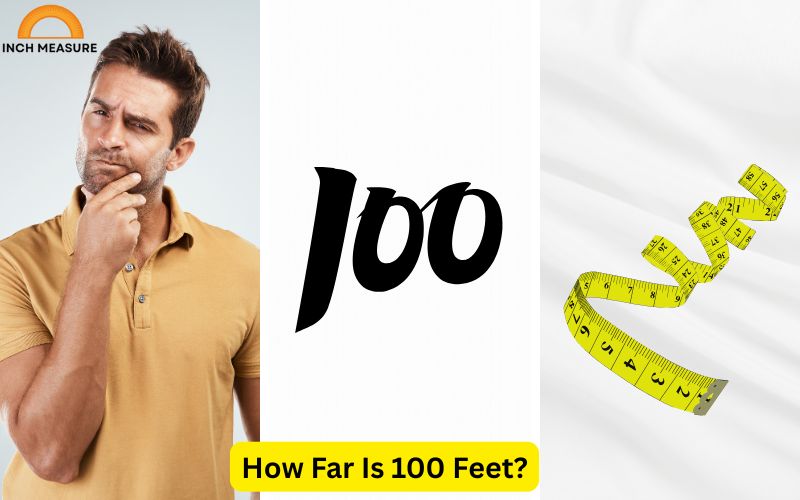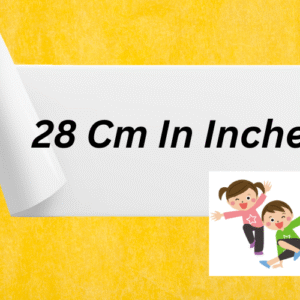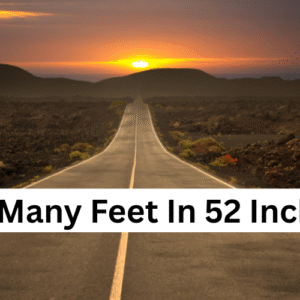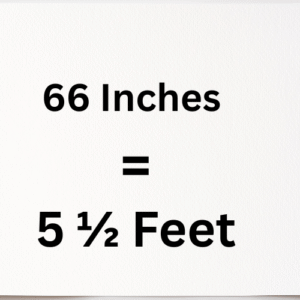Imagine standing at the edge of a vibrant festival, eyeing a stage exactly 100 feet away, where music pulses through the crowd. Or picture pacing the length of a majestic blue whale, its 100-foot form stretching across a serene ocean shore. The distance of 100 feet is both ordinary and extraordinary, woven into the fabric of our daily lives—yet how often do we truly grasp its scale? This article embarks on an immersive exploration of 100 feet, unveiling its significance through vivid comparisons, practical applications, and relatable scenarios. From sports fields to city streets, we’ll anchor this measurement to 11 everyday items, each approximately 100 feet, to make it tangible and memorable. With detailed insights and handy tables, we’ll transform 100 feet from an abstract number into a distance you can feel, see, and understand in the world around you.
What Is 100 Feet?
To begin, let’s establish what 100 feet represents. In the imperial system, a foot is a unit of length equal to 12 inches, and 100 feet is simply 100 of these units. In metric terms, 100 feet is approximately 30.48 meters (since 1 foot equals 0.3048 meters). This distance is significant enough to be meaningful in many contexts but small enough to be relatable in everyday life.
To put it into perspective, 100 feet is roughly the length of a standard basketball court (94 feet in the NBA) or about one-third the length of a football field (300 feet, excluding end zones). It’s a distance you might walk in a few seconds or the height of a mid-sized building. Understanding 100 feet is useful for estimating distances without tools, planning spaces, or visualizing scenarios in sports, architecture, or outdoor activities.
Why 100 Feet Matters
The 100-foot mark is often used as a benchmark in various fields. For example:
- Safety Regulations: Fire codes may require exits to be within 100 feet of occupants in a building.
- Sports: The 100-yard dash (slightly longer at 300 feet) is a classic track event, but 100 feet is a useful reference for shorter sprints or field measurements.
- Construction and Real Estate: Lot sizes, building heights, or setback requirements often reference distances close to 100 feet.
- Everyday Estimation: When someone says, “It’s about 100 feet away,” having a mental image of that distance helps in decision-making or navigation.
To make 100 feet more relatable, we’ll explore it through 11 everyday items or scenarios, each approximately 100 feet in length or distance. These examples will provide a concrete sense of the measurement, grounded in objects and settings you encounter regularly.
Visualizing 100 Feet: The Importance of Context
Before diving into specific examples, let’s consider why visualizing 100 feet is valuable. Humans are better at understanding distances when they can relate them to familiar objects or experiences. For instance, saying “100 feet is about the length of a school bus” is more intuitive than stating “100 feet is 1,200 inches.” By anchoring the measurement to everyday items, we can better grasp its scale and apply it to real-world situations.
To further aid visualization, we’ll also include tables comparing 100 feet to other units of measurement and providing quick references for the items discussed. These tables will serve as handy tools for readers who want to quickly understand or compare distances.
100 Feet in Different Units of Measurement
| Unit | Equivalent to 100 Feet |
| Feet | 100 feet |
| Inches | 1,200 inches |
| Yards | 33.33 yards |
| Meters | 30.48 meters |
| Kilometers | 0.03048 kilometers |
| Miles | 0.01894 miles |
| Centimeters | 3,048 centimeters |
This table provides a quick reference for converting 100 feet into other common units, helping readers contextualize the distance in their preferred measurement system.
11 Everyday Items That Are Approximately 100 Feet
Below, we explore 11 everyday items or scenarios that are roughly 100 feet in length or distance. Each section is designed to provide a detailed, relatable description, making the concept of 100 feet vivid and understandable. These examples span various settings, from transportation and sports to architecture and nature, ensuring a broad perspective.
1. A Standard Basketball Court
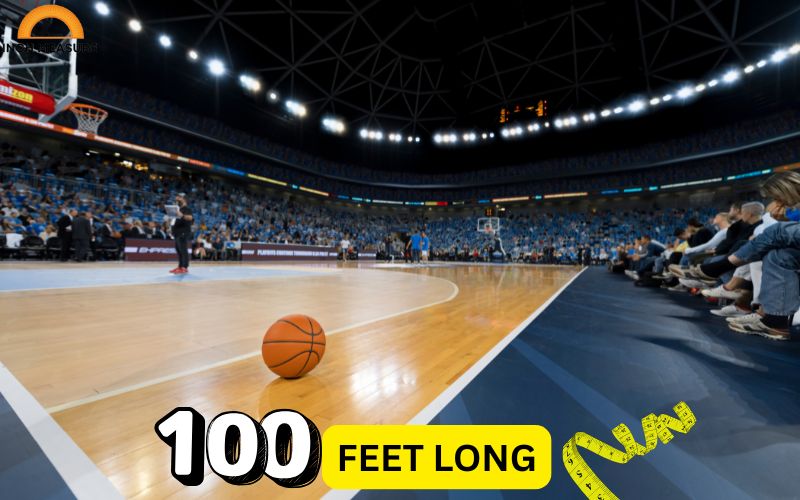
A standard NBA basketball court measures 94 feet in length, making it an excellent approximation of 100 feet. Including the out-of-bounds areas, the total length often approaches or exceeds 100 feet. Visualizing a basketball court is a great way to grasp this distance because it’s a familiar setting for many, whether you’ve played on one, watched a game, or seen one in a school gymnasium.
Basketball courts are rectangular, with a playing surface that’s 50 feet wide and 94 feet long in professional settings. The court is divided into two halves by the midcourt line, and each half is about 47 feet—meaning two halves plus a bit of extra space (like the area behind the baskets) get you very close to 100 feet. Imagine standing at one baseline and looking toward the opposite basket; that’s nearly 100 feet of polished hardwood.
This distance is significant in basketball because it represents the full length players must cover during fast breaks or defensive transitions. For fans, it’s the distance from one end of the court to the other, where iconic plays like a buzzer-beater or a full-court pass unfold. If you’ve ever walked the length of a basketball court, you’ve essentially walked 100 feet.
Beyond”?
Beyond sports, this visualization is useful in other contexts. For example, if you’re planning an event in a gym and need to estimate space, picturing a basketball court gives you a sense of how far 100 feet stretches. It’s also a relatable reference for urban dwellers who may encounter similar-sized indoor spaces in community centers or schools.
To further contextualize, consider that a basketball court’s length is about one-third of a football field or roughly the height of a 10-story building. This makes it a versatile reference point for both horizontal and vertical distances.
Key Takeaway: A basketball court’s length (94 feet, plus a few extra feet) is a near-perfect visualization of 100 feet, familiar to anyone who’s been in a gym or watched a game.
2. A City Block (Short Side)
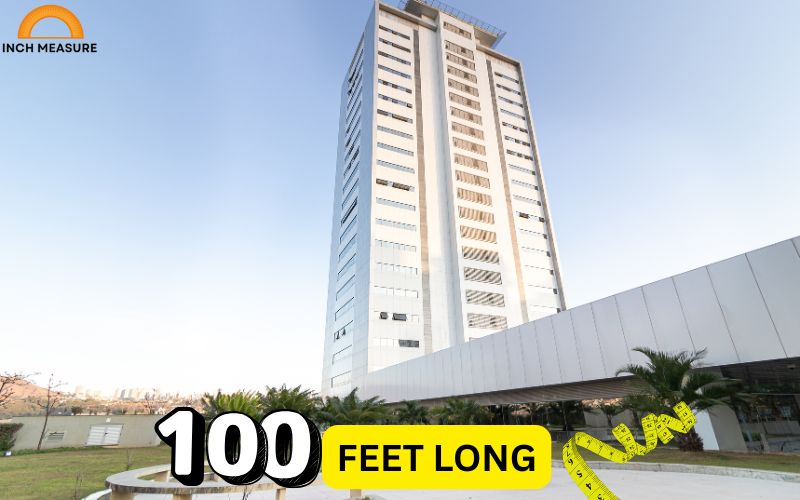
In many cities, the short side of a city block is approximately 100 feet long. While city block sizes vary widely depending on location (e.g., Manhattan’s blocks are about 200–300 feet on the short side), smaller cities or towns often have blocks closer to 100 feet in length, especially in residential areas.
Walking the short side of a city block gives you a practical sense of 100 feet. Imagine strolling from one street corner to the next, passing a few storefronts, parked cars, or residential buildings. This distance is short enough to cover in about 20–30 seconds at a leisurely pace (assuming a walking speed of 3–4 feet per second), but it’s long enough to feel like a distinct segment of your journey.
City blocks are a useful reference because they’re part of daily life for urban residents. Whether you’re walking to a coffee shop, crossing the street, or estimating how far a bus stop is, the short side of a block provides a tangible 100-foot marker. In suburban areas, this distance might equate to the width of a few house lots or the space between streetlights.
This visualization is also practical for urban planning or real estate. For example, zoning regulations might require buildings to be set back 100 feet from a property line, roughly the length of a short city block. Similarly, when navigating a city, knowing that a destination is “about one block away” can translate to roughly 100 feet in some contexts.
Key Takeaway: The short side of a city block, especially in smaller towns, is often around 100 feet, making it a relatable urban reference for this distance.
3. A Large Passenger Jet
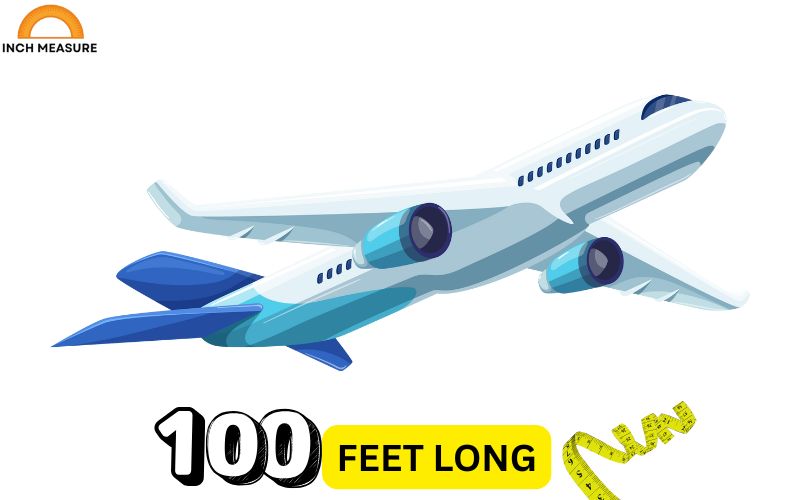
A large passenger jet, such as a Boeing 737 or Airbus A320, is approximately 100 feet long. For example, a Boeing 737-800 measures about 129 feet, but smaller models or sections of larger planes (like the fuselage without wings) can be closer to 100 feet. Visualizing a jet parked on a tarmac gives you a sense of this distance.
Picture yourself standing at the nose of a jet and looking toward its tail. The sleek, cylindrical body stretches about 100 feet, encompassing rows of windows, passenger cabins, and cargo holds. This is a distance you might walk when boarding a plane via a jet bridge or crossing a tarmac to reach a smaller aircraft.
In aviation, 100 feet is significant for runway spacing, taxiway widths, or the distance between planes at gates. For travelers, it’s the length of the plane you’re boarding, a distance that feels substantial when you’re walking down the aisle to your seat. For those who’ve never been on a plane, imagine a long bus or train car, then scale it up slightly—that’s roughly 100 feet.
This visualization is also useful for understanding scale in other contexts, like comparing the jet’s length to buildings or vehicles. For example, a 100-foot jet is about the length of a 10-story building laid flat or two school buses parked end-to-end.
Key Takeaway: A large passenger jet, around 100 feet long, is a striking visual for this distance, especially for those familiar with airports or air travel.
4. A Football Field’s Width
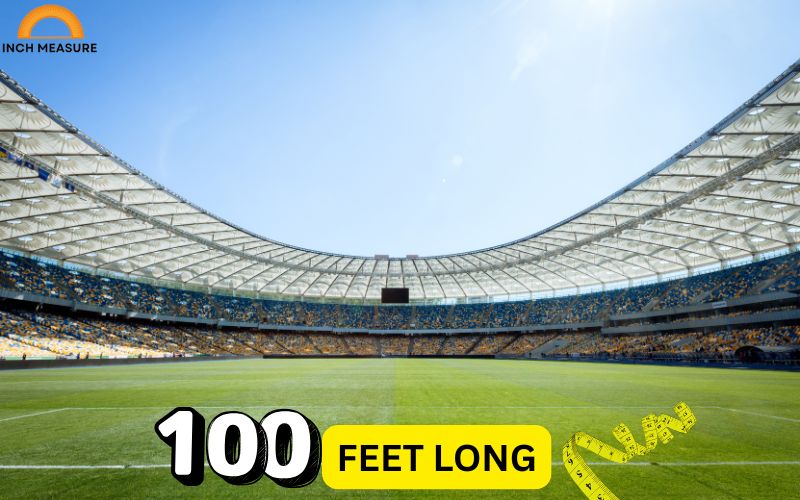
While a football field’s length (300 feet without end zones) is much longer than 100 feet, its width is closer to this measurement. An American football field is 160 feet wide (53.33 yards), but the playable area, including sidelines, often feels closer to 100 feet when visualized from one sideline to the other.
Imagine standing on one sideline of a football field, looking across to the opposite side. The distance—about 100 feet if you focus on the main playing area or a portion of the field—is a good approximation. This is the space where players run routes, defend passes, or chase down opponents during a game.
For sports fans, this visualization is intuitive because football fields are iconic and widely recognized. The width of the field is where much of the game’s action unfolds, from lateral passes to sideline catches. If you’ve ever walked across a football field during a school event or game, you’ve likely covered a distance close to 100 feet.
This reference is also useful for non-sports contexts. For example, if you’re planning an outdoor event, picturing the width of a football field gives you a sense of how much space 100 feet covers. It’s also a helpful benchmark for estimating distances in large open spaces, like parks or festival grounds.
Key Takeaway: The width of a football field (or a portion of it) is a relatable way to visualize 100 feet, especially for sports enthusiasts.
5. A 10-Story Building’s Height
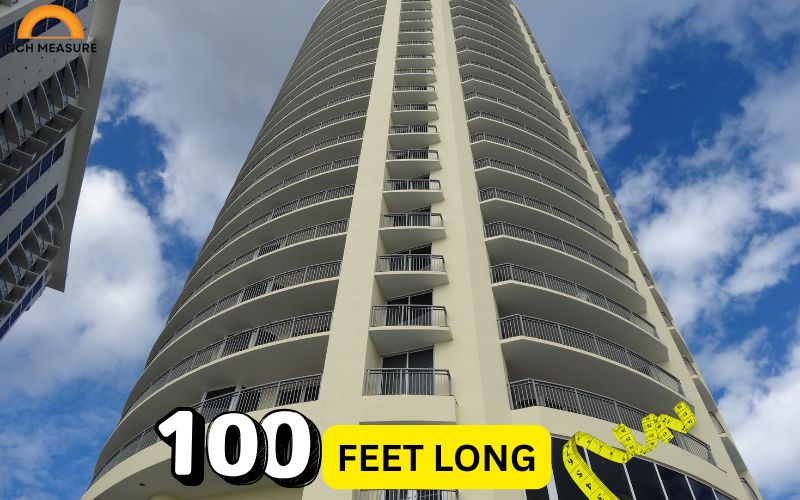
The height of a 10-story building is approximately 100 feet. In architecture, a standard floor in a commercial or residential building is about 10 feet tall (including the floor and ceiling structure), so a 10-story building reaches roughly 100 feet in height.
Picture standing at the base of a mid-rise office building or apartment complex and looking up to its roof. That vertical distance—about 100 feet—is the height of a typical 10-story structure. This is a powerful visualization because buildings are a constant presence in urban and suburban environments, making it easy to relate to this scale.
In practical terms, 100 feet is significant in construction and safety. For example, fire truck ladders often extend to around 100 feet to reach upper floors of mid-rise buildings. Similarly, building codes may require elevators or stairwells to be spaced within 100 feet for accessibility.
For those who’ve never been in a tall building, imagine stacking 10 single-story houses on top of each other. The total height would be close to 100 feet. This visualization helps bridge the gap between horizontal and vertical distances, showing that 100 feet is substantial in both contexts.
Key Takeaway: A 10-story building’s height, around 100 feet, is a vivid way to visualize this distance in urban settings.
6. A Row of 20 Parked Cars
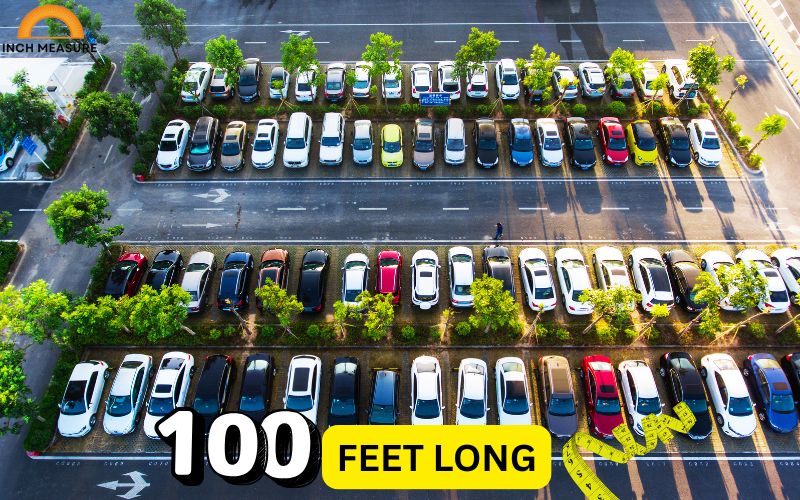
A typical car is about 15–20 feet long, depending on the make and model (e.g., a compact car might be 15 feet, while an SUV could be closer to 20 feet). If you line up 20 compact cars end-to-end, the total length is approximately 100 feet (20 cars × 5 feet per car = 100 feet).
Imagine walking along a street where cars are parked bumper-to-bumper, as in a busy city or parking lot. Counting 20 cars gives you a sense of 100 feet. This is a relatable visualization because cars are ubiquitous, and most people have walked past rows of parked vehicles.
This example is also practical for estimating distances in everyday scenarios. For instance, if you’re trying to gauge how far 100 feet is while parking or walking to a store, picturing 20 cars in a row provides a clear mental image. It’s also useful for urban planning, where parking spaces or street lengths are often measured in increments close to 100 feet.
Key Takeaway: A row of 20 parked cars, stretching about 100 feet, is an everyday visual for this distance, especially in urban or suburban settings.
7. A Standard Swimming Pool (with Deck)
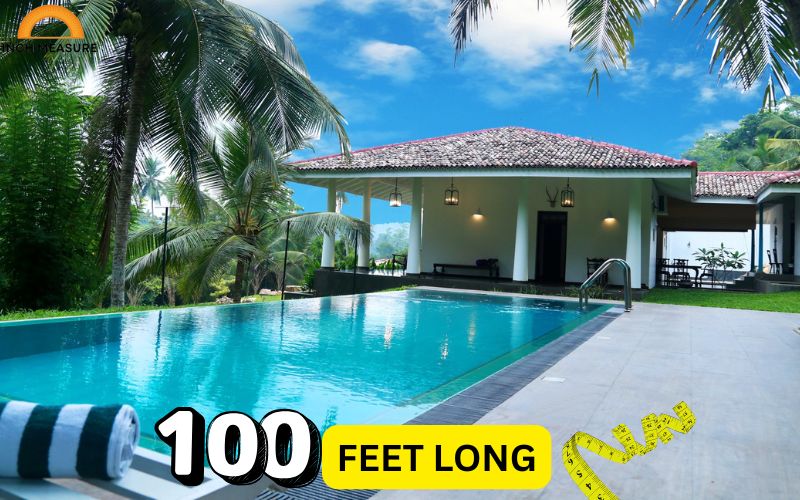
An Olympic-sized swimming pool is 50 meters long (approximately 164 feet), but many community or high school pools are closer to 25 yards (75 feet) or 25 meters (82 feet). However, if you consider the pool’s length plus the surrounding deck or seating area, the total distance often approaches 100 feet.
Picture standing at one end of a community pool and looking toward the opposite end, including the deck space. That distance—about 100 feet—captures the pool’s length plus a bit of extra space. Swimming pools are familiar to many, whether from school, local recreation centers, or vacations, making this a relatable reference.
In swimming, 100 feet is significant because it’s roughly the distance of a short-course race (e.g., 100 yards or 91.44 meters). Swimmers cover this distance in a matter of seconds, but for non-swimmers, walking around the pool’s perimeter gives a sense of the scale.
This visualization is also useful for planning outdoor spaces, like backyards or community centers, where a pool’s size might be compared to a 100-foot benchmark. It’s also a reminder of how distances feel different depending on the context—swimming 100 feet feels different from walking it.
Key Takeaway: A community swimming pool, including its deck, is about 100 feet long, offering a familiar aquatic reference for this distance.
8. A Typical Streetlight Spacing
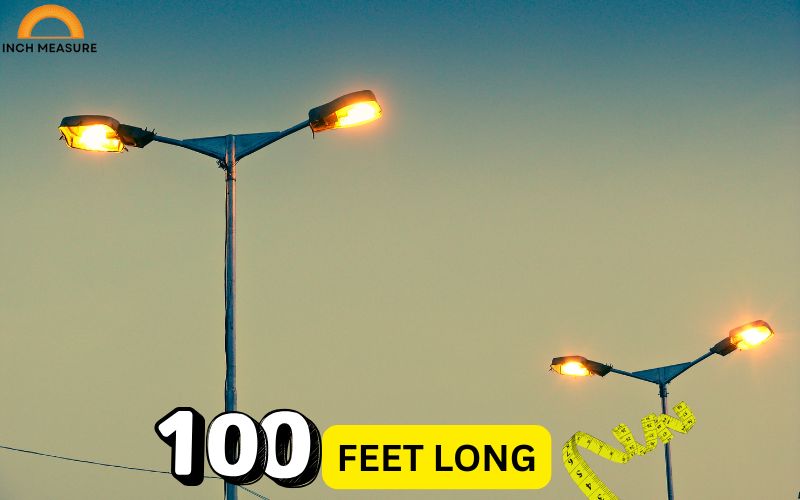
In many cities, streetlights are spaced approximately 100–150 feet apart, depending on the area’s design and lighting requirements. In residential neighborhoods or smaller towns, the spacing is often closer to 100 feet, making this a practical visualization for 100 feet.
Imagine walking down a sidewalk at night, passing from one streetlight’s glow to the next. The distance between two streetlights—about 100 feet—represents a short but noticeable segment of your walk. This is a distance you might cover while heading to a neighbor’s house or crossing a street.
Streetlight spacing is a useful reference because it’s a common feature of urban and suburban environments. Whether you’re estimating how far a destination is or planning a route, picturing the distance between streetlights gives you a sense of 100 feet. It’s also relevant for city planners or engineers designing lighting layouts.
Key Takeaway: The distance between streetlights, often around 100 feet, is a practical urban reference for visualizing this distance.
9. A Large Yacht
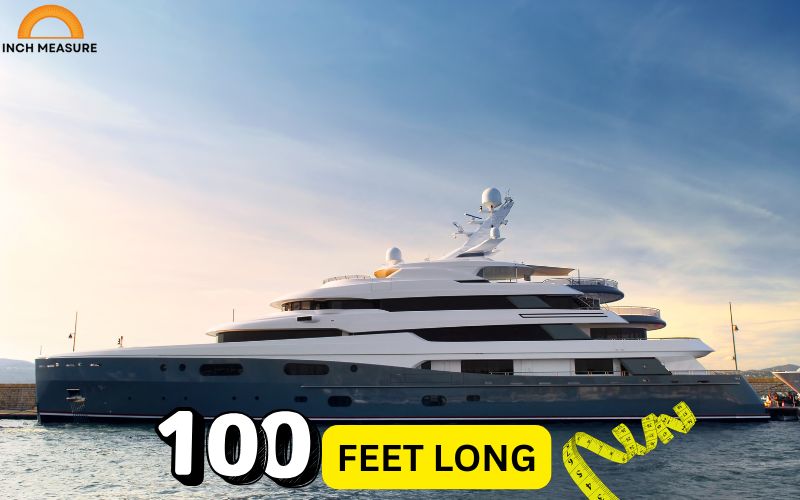
A large yacht, such as those used for luxury cruises or private charters, is often around 100 feet long. For example, a mid-sized superyacht might measure 80–120 feet, with many models hitting close to the 100-foot mark.
Picture standing at the bow of a yacht and looking toward its stern. The sleek, elegant vessel stretches about 100 feet, encompassing multiple decks, cabins, and outdoor areas. This is a distance you might walk when exploring the yacht or moving from one end to the other during a cruise.
For those who’ve never been on a yacht, imagine a long, luxurious boat docked at a marina. Its length is comparable to a basketball court or a row of 20 cars, making it a striking visual for 100 feet. In maritime contexts, 100 feet is significant for docking, navigation, or comparing vessel sizes.
This visualization is also useful for coastal residents or those familiar with marinas, where yachts are a common sight. It’s a reminder that 100 feet is a substantial but manageable distance, even on water.
Key Takeaway: A 100-foot yacht is a luxurious and vivid way to visualize this distance, especially for those familiar with boating or coastal areas.
10. A Row of 10 Standard Shipping Containers
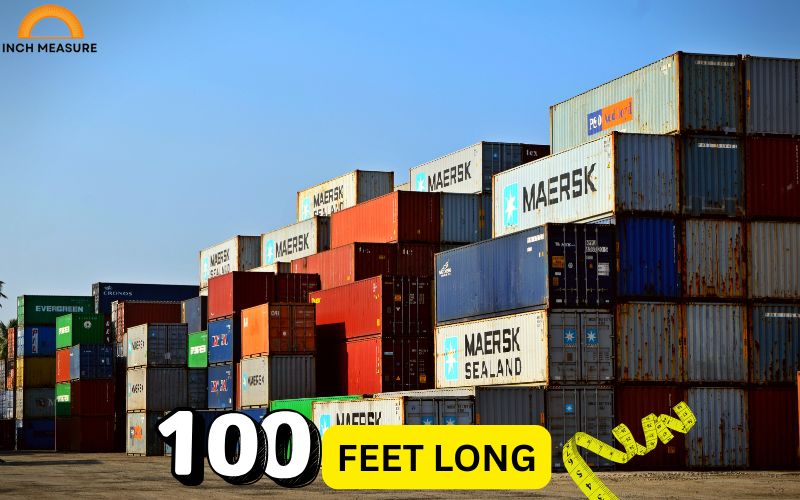
A standard shipping container (often called a TEU, or Twenty-foot Equivalent Unit) is 20 feet long. Lining up five such containers end-to-end gives you exactly 100 feet (5 × 20 feet = 100 feet).
Imagine walking past a row of shipping containers at a port, warehouse, or construction site. These massive metal boxes, used to transport goods worldwide, create a 100-foot line when five are placed end-to-end. This is a relatable visualization for anyone who’s seen containers stacked at a shipping yard or repurposed for buildings or storage.
In logistics, 100 feet is significant for planning storage, transportation, or loading areas. For example, a 100-foot row of containers might represent a small section of a cargo ship’s deck or a warehouse’s storage area. For everyday purposes, picturing five containers gives a clear sense of scale, especially in industrial or urban settings.
Key Takeaway: Five 20-foot shipping containers, totaling 100 feet, provide an industrial visual for this distance, common in ports and warehouses.
11. A Large Blue Whale
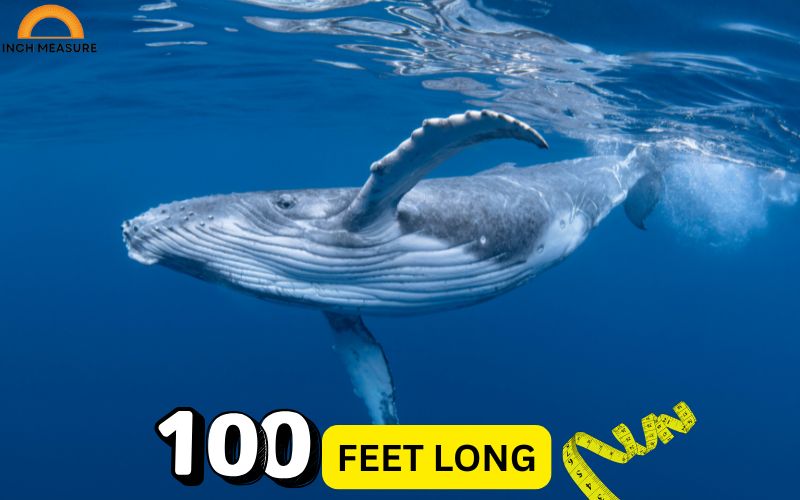
The blue whale, the largest animal on Earth, can grow up to 100 feet in length. While some individuals are slightly shorter or longer, 100 feet is a standard approximation for an adult blue whale’s length.
Picture a blue whale swimming alongside a boat or lying on a beach (as seen in documentaries or marine exhibits). Its massive body, from nose to tail, stretches about 100 feet, encompassing its enormous head, streamlined body, and powerful flukes. This is a breathtaking visualization because it connects 100 feet to a living creature, emphasizing the scale of nature.
In marine biology, 100 feet is a benchmark for comparing animal sizes. For example, a blue whale’s length is about twice that of a school bus or the height of a 10-story building. For those who’ve visited aquariums or seen whale models, this image is particularly vivid.
This visualization also sparks wonder, as it reminds us that 100 feet is not just a measurement but a representation of life’s diversity. Whether you’re at the ocean or imagining a whale in a museum, picturing this creature gives a profound sense of 100 feet.
Key Takeaway: A 100-foot blue whale is a stunning natural reference for this distance, connecting measurement to the wonders of marine life.
Summary of Everyday Items Approximately 100 Feet
| Item | Approximate Length | Context |
| Basketball Court | 94–100 feet | Sports, gymnasiums |
| City Block (Short Side) | ~100 feet | Urban navigation, real estate |
| Large Passenger Jet | ~100 feet | Aviation, travel |
| Football Field Width | ~100 feet (playable area) | Sports, outdoor events |
| 10-Story Building Height | 100 feet | Architecture, safety |
| Row of 20 Parked Cars | 100 feet | Urban settings, parking |
| Swimming Pool (with Deck) | ~100 feet | Recreation, community centers |
| Streetlight Spacing | ~100 feet | Urban planning, navigation |
| Large Yacht | ~100 feet | Maritime, luxury |
| 5 Shipping Containers | 100 feet | Logistics, industry |
| Blue Whale | ~100 feet | Marine biology, nature |
This table summarizes the 11 everyday items, providing a quick reference for their approximate lengths and relevant contexts.
Practical Applications of 100 Feet
Beyond visualization, understanding 100 feet has practical applications in various fields. Here are a few examples:
- Construction and Architecture: Builders use 100 feet as a reference for setbacks, lot sizes, or building heights. For instance, a 100-foot buffer zone might be required between structures for safety.
- Sports and Fitness: In track and field, 100 meters (328 feet) is a standard race, but 100 feet is a useful shorter distance for training or casual sprints.
- Safety and Emergency Planning: Fire codes often specify that exits must be within 100 feet of occupants, and fire truck ladders are designed to reach about 100 feet.
- Navigation and Estimation: When hiking, driving, or walking, estimating 100 feet helps gauge distances to landmarks or destinations.
Practical Scenarios Involving 100 Feet
| Scenario | Use of 100 Feet |
| Fire Safety | Distance to nearest exit in buildings |
| Sports Training | Short sprint or field measurement |
| Construction | Setback requirements, lot sizing |
| Urban Planning | Streetlight spacing, block design |
| Maritime Navigation | Yacht docking, vessel sizing |
| Wildlife Observation | Estimating animal sizes (e.g., blue whale) |
This table highlights how 100 feet is applied in practical scenarios, reinforcing its relevance in daily life.
Comparing 100 Feet to Other Distances
To further contextualize 100 feet, let’s compare it to other common distances:
- 100 Yards: 100 yards is 300 feet, three times the length of 100 feet. It’s the length of a football field (excluding end zones).
- 1 Mile: A mile is 5,280 feet, so 100 feet is about 1.89% of a mile—quite short in comparison.
- 100 Meters: 100 meters is 328 feet, making it significantly longer than 100 feet.
- Height of the Statue of Liberty: The Statue of Liberty is about 305 feet tall (including its pedestal), so 100 feet is roughly one-third of its height.
These comparisons help anchor 100 feet in a broader context, showing it as a moderate but significant distance.
Challenges in Estimating 100 Feet
Estimating 100 feet without tools can be challenging because human perception of distance varies. For example:
- In open spaces (like fields), 100 feet may seem shorter due to a lack of reference points.
- In crowded or cluttered environments (like cities), 100 feet may feel longer due to obstacles or visual distractions.
- Vertical distances (like building heights) are harder to estimate than horizontal ones because we rarely measure heights directly.
Using familiar items, like those listed above, helps overcome these challenges by providing mental benchmarks. Practicing estimation with these references can improve your ability to gauge 100 feet accurately.
Cultural and Historical Significance of 100 Feet
The number 100 has cultural significance in many societies, often symbolizing completeness or a milestone. In measurement, 100 feet is a round, memorable number that’s easy to use as a reference. Historically, distances like 100 feet were used in architecture (e.g., ancient temples) or land division (e.g., early surveying).
In modern times, 100 feet remains a practical benchmark. For example, in the U.S., property lines, building codes, and sports fields often use 100 feet or multiples thereof due to the imperial system’s prevalence. In metric countries, 30 meters (close to 100 feet) serves a similar role.
You May Also Need To Know: How Many Feet is 48 Inches?
Conclusion
Understanding how far 100 feet is becomes much easier when you relate it to everyday items and scenarios. From the length of a basketball court to the height of a 10-story building, these visualizations make 100 feet tangible and relatable. Whether you’re navigating a city, planning a project, or simply curious about distances, picturing these 11 items—each around 100 feet—provides a clear mental image.
By combining detailed descriptions, practical applications, and comparative tables, this article has aimed to make 100 feet a familiar and useful measurement. Next time someone says, “It’s about 100 feet away,” you’ll have a wealth of references to picture exactly what that means. Whether it’s a row of parked cars, a blue whale, or the width of a football field, 100 feet is a distance that’s all around us, waiting to be recognized.
Convert Inches to Meters, cm, mm, and Feet
Converted Values:
Meters (m): 1.016
Centimeters (cm): 101.60
Millimeters (mm): 1016.00
Feet (ft): 3.33

